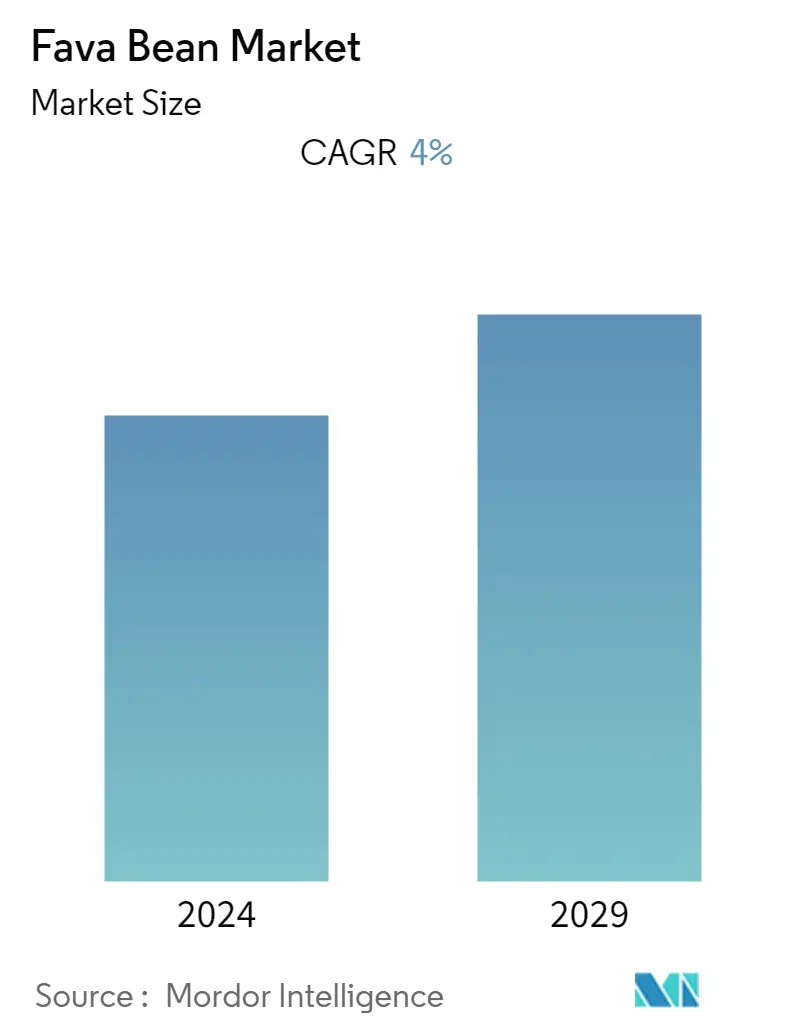Market Size of Fava Bean Industry

| Study Period | 2019 - 2029 |
| Base Year For Estimation | 2023 |
| Forecast Data Period | 2024 - 2029 |
| CAGR | 4.00 % |
| Fastest Growing Market | North America |
| Largest Market | Asia-Pacific |
Fava Beans Market Analysis
The global fava bean market is projected to register a CAGR of 4.0% during the forecast period.
- The market is being driven by the increasing consumption of fava beans owing to the rising interest in adopting a healthy lifestyle and nutritious diet. Fava beans are a good source of protein, fiber, and carbohydrates. In terms of mineral content, fava beans are rich in calcium, iron, and magnesium, among others. The drive towards maintaining a healthy lifestyle through healthy eating trends and increasing awareness about the benefits associated with fava beans has spurred market growth.
- Fava beans are increasingly used in various recipes across Middle Eastern and Asian cuisines as they are an excellent and versatile addition to a healthy, balanced diet. In addition, the rising trend of vegetarianism is also anticipated to bolster the consumption of fava beans in the coming years. Fava beans are considered effective in maintaining blood pressure, boosting the immune system, and improving bone health in the human body. Fava bean flour is also used in the production of bread and pasta, which drives the global fava bean market. Continuous volatility in fava beans prices hinders the growth of the global fava beans market.
- For the past few years, there has been an increasing trend of veganism in Europe and the United States, spreading worldwide. Moreover, people are focused on plant-based diets, which has been the reason for the higher consumption of fava beans. The intake of animal protein, which is associated with high cholesterol levels, fat, and calories, increases the risk of cardiac diseases, high blood sugar levels, and obesity. Hence, people are showing an inclination toward vegan sources of protein.
Fava Beans Industry Segmentation
Fava beans are the edible seeds of the legume crop Vicia faba, otherwise known as faba beans, horse beans, or broad beans. The seeds are around 2 to 3 cm long and occur in various colors, including yellow, green, brown, black, and even violet. It is widely cultivated as a crop for human consumption and as a cover crop.
The fava bean market includes production analysis (volume), consumption analysis (value and volume), export analysis (value and volume), import analysis (value and volume), and price trend analysis across the globe. The market is segmented by geography into North America, Europe, Asia-Pacific, South America, and Africa.
The report offers the market size and forecasts in terms of volume in metric ton and value in USD thousand for all the above segments.
| Geography (Production Analysis, Consumption Analysis by Value & Volume, Import Analysis by Value & Volume, Export Analysis by Value & Volume and Price Trend Analysis) | |||||||||
| |||||||||
| |||||||||
| |||||||||
| |||||||||
|
Fava Bean Market Size Summary
The global fava bean market is experiencing growth driven by the increasing consumer interest in healthy lifestyles and nutritious diets. Fava beans are recognized for their high protein, fiber, and mineral content, making them a popular choice among health-conscious individuals. The rising trend of vegetarianism and veganism, particularly in Europe and the United States, is further boosting the demand for fava beans as a plant-based protein source. The versatility of fava beans in various cuisines, especially in Middle Eastern and Asian dishes, along with their use in products like bread and pasta, contributes to their growing popularity. However, price volatility remains a challenge for the market's expansion.
The Asia-Pacific region, led by China, is the primary producer of fava beans, with significant production increases driven by rising consumer demand and export potential. The region's focus on plant-based diets and the benefits of legumes in cropping systems support the market's growth. Initiatives by organizations like the European Vegetarian Union and strategies from the European Union to promote plant-based diets further encourage the shift away from animal products. Recent developments, such as partnerships and new fava bean varieties, are expected to enhance market offerings and meet the increasing global demand for this nutritious legume.
Fava Bean Market Size - Table of Contents
-
1. MARKET DYNAMICS
-
1.1 Market Overview
-
1.2 Market Drivers
-
1.3 Market Restraints
-
1.4 Value Chain Analysis
-
-
2. MARKET SEGMENTATION
-
2.1 Geography (Production Analysis, Consumption Analysis by Value & Volume, Import Analysis by Value & Volume, Export Analysis by Value & Volume and Price Trend Analysis)
-
2.1.1 North America
-
2.1.1.1 United States
-
2.1.1.2 Canada
-
2.1.1.3 Mexico
-
-
2.1.2 Europe
-
2.1.2.1 Germany
-
2.1.2.2 United Kingdom
-
2.1.2.3 France
-
2.1.2.4 Russia
-
2.1.2.5 Spain
-
2.1.2.6 Sweden
-
2.1.2.7 Italy
-
-
2.1.3 Asia-Pacific
-
2.1.3.1 China
-
2.1.3.2 Japan
-
2.1.3.3 Australia
-
2.1.3.4 Iran
-
-
2.1.4 South America
-
2.1.4.1 Argentina
-
2.1.4.2 Peru
-
2.1.4.3 Brazil
-
-
2.1.5 Africa
-
2.1.5.1 Ethiopia
-
2.1.5.2 Egypt
-
2.1.5.3 Sudan
-
2.1.5.4 Morocco
-
-
-
Fava Bean Market Size FAQs
What is the current Fava Bean Market size?
The Fava Bean Market is projected to register a CAGR of 4% during the forecast period (2024-2029)
Which is the fastest growing region in Fava Bean Market?
North America is estimated to grow at the highest CAGR over the forecast period (2024-2029).

